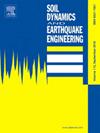Cumulative plastic strain and shakedown analysis in loess subgrades under intermittent loads
IF 4.2
2区 工程技术
Q1 ENGINEERING, GEOLOGICAL
引用次数: 0
Abstract
In previous train operations, traffic loads were typically considered continuous, disregarding the intermittent effects of successive trains on subgrade loess. To investigate the cumulative plastic strain behavior and critical dynamic stress of subgrade loess under intermittent train loads, a series of dynamic triaxial tests were conducted considering factors such as cyclic stress ratio, confining pressure, and frequency. The deformation characteristics of subgrade soil under different stress levels were analyzed, and the dynamic behavior of specimens was categorized based on the development trends of strain rate and cumulative plastic strain. Then the critical dynamic stress levels for plastic shakedown and plastic creep states were determined. The results indicate that intermittent effects suppress the development of cumulative plastic strain and excess pore water pressure in the soil. The more cycles of the unloading-drainage stage the soil undergoes, the stronger its resistance to failure. Under intermittent loads, cumulative plastic strain increases with higher cyclic stress ratios and frequencies. When the cyclic stress ratio is constant, the increase in confining pressure enhances soil stiffness, but this increase is insufficient to counteract the strain induced by greater dynamic stress amplitude, resulting in increased cumulative strain. Combining cumulative plastic strain and plastic strain rate, a classification standard for the deformation behavior of subgrade loess under intermittent loading conditions was established, and the critical dynamic stress was identified. The critical dynamic stress increases with higher confining pressure but decreases with frequency. Accordingly, empirical formulas for critical dynamic stress concerning confining pressure and frequency were proposed. These findings are crucial for understanding the mechanism of intermittent train load effects and analyzing subgrade settlement.
求助全文
约1分钟内获得全文
求助全文
来源期刊

Soil Dynamics and Earthquake Engineering
工程技术-地球科学综合
CiteScore
7.50
自引率
15.00%
发文量
446
审稿时长
8 months
期刊介绍:
The journal aims to encourage and enhance the role of mechanics and other disciplines as they relate to earthquake engineering by providing opportunities for the publication of the work of applied mathematicians, engineers and other applied scientists involved in solving problems closely related to the field of earthquake engineering and geotechnical earthquake engineering.
Emphasis is placed on new concepts and techniques, but case histories will also be published if they enhance the presentation and understanding of new technical concepts.
 求助内容:
求助内容: 应助结果提醒方式:
应助结果提醒方式:


